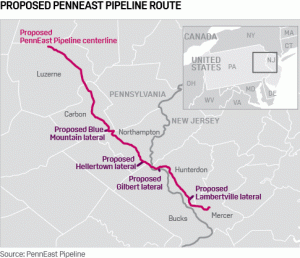From an Article by Maya Weber, S & P Global, September 3, 2020
Washington — The Federal Energy Regulatory Commission’s favorable environmental assessment for the phased-in PennEast Pipeline project generated hundreds of critical comments from environmental groups and residents opposed to one of the only large Northeast gas pipeline projects still pending at the commission.
The roughly 118-mile, 1.1 Bcf/d project, originally intended to link Marcellus Shale dry gas production with markets in Pennsylvania, New Jersey, and New York has faced hurdles in New Jersey, and an appeals court ruling thwarting its ability to condemn lands in which the state held an interest.
To advance the project, PennEast proposed to amend the authorization and begin with a first phase: a 68-mile segment in Pennsylvania with the capacity to carry 695,000 Dt/d. A second phase segment, mostly in New Jersey, would enable the full capacity.
The FERC staff Aug. 3 released an environmental assessment that found the two-phase approach would not constitute a major federal action significantly affecting the environment. The report focused mostly on new, limited facilities within a 2.1-acre site, the Church Road interconnects in Bethlehem Township, Pennsylvania, while considering some cumulative impacts of shifting to a phased approach.
Between Aug. 27 and Sept. 3, more than 500 comments flowed into FERC about the report. Multiple commenters argued it was wrong to narrow the focus to the Church Road Interconnects when, they argued, the Phase 1 amendment would alter the entire project’s certificated purpose and need.
A number of commenters, including New Jersey regulators, also argued that more environmental survey data is available than when the original environmental impact statement was conducted, but that FERC had not pulled that new information into its analysis.
Others found fault with FERC’s consideration of the project purpose and need, now that it has been divided into two phases, arguing evidence of market support amounted to 57% of the first phase capacity, which is contracted to project affiliates.
Delaware Riverkeeper Network and Clean Air Council argued that PennEast’s proposal is not a mere phasing of construction but a reconfiguration of the original project, and thus an environmental impact statement is required.
The “tenuous justification” for the construction of Phase 1, combined with the likelihood that Phase 2 will never be built, demands that FERC treat PennEast’s proposal as a different project than the original PennEast Pipeline, rather than a single amendment, the environmental groups argued.
New Jersey Conservation Foundation, in comments filed jointly with the Watershed Institute, Niskanen Center and landowners potentially affected, wrote that the National Environmental Policy Act requires FERC to do more than “peddle a forgone conclusion.”
“Rather than requiring PennEast to support its assertion of project need, the commission: (1) has refused to engage with need in its NEPA analysis; (2) used a presumption of need to find that any no-action scenario would involve a new build of a different 1.1 million Dt/d pipeline; and (3) certified that building this hypothetical new project would cause similar environmental harms,” they wrote.
On a more granular level, they argued FERC failed to secure data absent in the first EIS related to impacts of horizontal directional drilling.
“At this juncture, and based on this administrative record, certifying that a project will have no significant adverse impacts because PennEast will use HDD under sensitive resources is magical thinking — not reasoned decision-making,” they wrote.
Further, they contended that by focusing on impacts from the Church Road interconnects, the EA completely ignores impacts the 2020 project would have on landowners along any other part of the 68.2 miles in Phase 1.
PennEast spokeswoman Pat Kornick said the project has provided a thorough and complete amended application found to be in the public need and benefit with minimal environmental impact. PennEast welcomes the feedback as part of the open and transparent regulatory process, she added.
“PennEast is committed to moving the project forward, including in the short term with Phase 1 construction and operation next year that will enable Pennsylvania families and businesses finally to realize the benefits of clean, low-cost natural gas.”
>>>>>>>>>>>>>>>>>>>>>>>>>>>>>>
See also: PennEast pipeline has been delayed 6 years, and the fight isn’t over | Letter, Jeff Tittel (Director, New Jersey Sierra Club), Lehigh Valley Live, August 18, 2020

